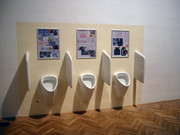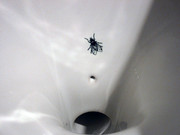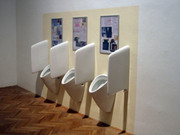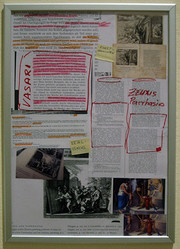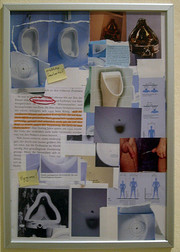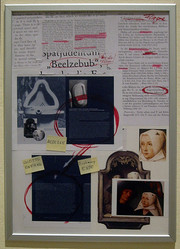Tausch - Täuschung - Enttäuschung
(an attraction from the theme park AVANT-GARDE)
2004
» video: urinal
In public toilets, one occasionally encounters urinals with a fly motif burnt into the glaze. The idea is to trick the user into aiming his jet of urine at the deceptively realistic image. This improves hygiene and helps cut cleaning costs.
Beyond such economic and health considerations, the “target fly” is a remarkable creature for other reasons: for the designer, it represents a successful user interface. And the fly and the urinal are symbolic cornerstones in the history of the development of art.
The urinal, that found its way into museums and into art history as a readymade, came to symbolize the paradigm shift in the art of the 20th century. Besides Duchamp’s much-analyzed strategies, the readymade redefines the relationship between portrayal and what is portrayed. The question of the hierarchy of object and image, of the mimetic function of art, is rendered obsolete. In Duchamp’s urinal, mimesis seems to find absurd fulfillment in the apparent identicalness of subject and artwork.
The legend of the painting contest between Zeuxis and Parrhasius features an illusion created by the apparent identicalness of subject and picture. The two painters were asked to paint a picture each. On the day of the unveiling, Zeuxis goes first, revealing the grapes he has painted: they are so realistic that the birds try to eat them. Zeuxis can hardly wait to see the work of Parrhasius and tries to pull back the curtain. But the curtain is the painted image of a curtain, and Zeuxis has been deceived. Parrhasius wins the contest because although Zeuxis was able to deceive the animals, Parrashius fooled a human - and an artist at that.
In the Renaissance, this anecdote is reinterpreted, and this time it is a fly that deceives the viewer. Vasari describes this trompe l’oeil fly created by Giotto: “It is said that when Giotto was only a boy with Cimabue, he once painted a fly on the nose of a face that Cimabue had drawn, so naturally that the master returning to his work tried more than once to drive it away with his hand, thinking it was real.” In the same passage, Vasari also notes that it was Giotto who “brought back to life the true art of painting.” Giotto’s fly, that appears to sit on the surface of the picture, not only redraws the border between the space of the picture and that of the viewer - it marks the border between Gothic and Renaissance. The fly became a symbol of a new way of painting that tried to imitate nature. From the point of view of art history, the fly establishes the difference between the traditional painter Cimabue and the progressive painter Giotto. As such, the fly becomes a symbol of artistic progress.
And this progressive period culminated in the arrival of the urinal in the hallowed halls of culture. The fly urinal presents us with an image of modern art as a closed circuit. Modernity’s teleological view of art becomes a historical period that has its anecdotal starting point in Giotto’s fly and its symbolic end point in Duchamp’s Fountain. The simultaneity of start and finish in the art history of the modern age reaches its highest symbolic density in the urinal equipped with a “target fly”. This symbolization takes place outside of the institutional art context. In pissoirs at airports, restaurants and other public conveniences equipped with signage systems, art-historical notions of progress are revealed not as a linear model, but as a time loop.
As a user of such conveniences (i.e. as a viewer) one finds oneself on the one hand in the position of the deceived party, trying hopelessly to drive away the fly with one’s jet of urine. Disappointed (enttäuscht) by the staying power of the image, the urinal user falls back into the role of the pre-modern artist. On the other hand, one is offered the opportunity of pissing on the ultimate symbol of the teleological ideology in art, thus distancing oneself from that whole period.
(Theo Ligthart)
